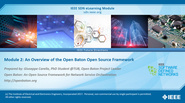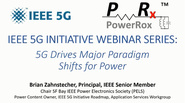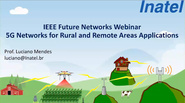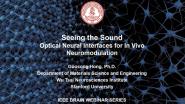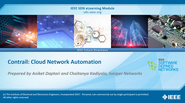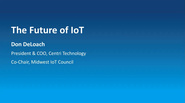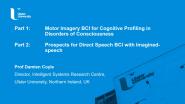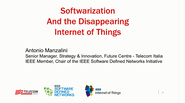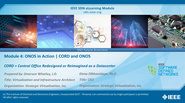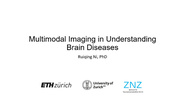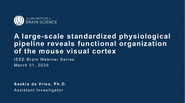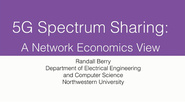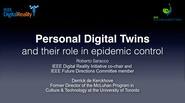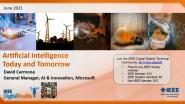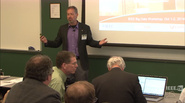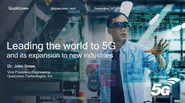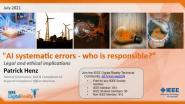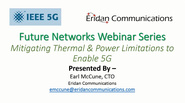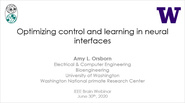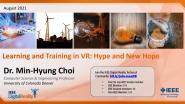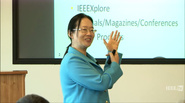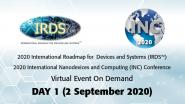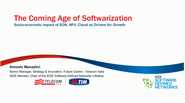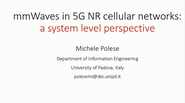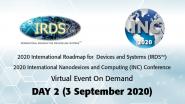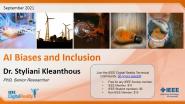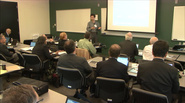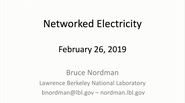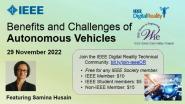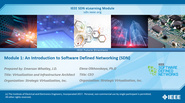
This collection of content is presented by the IEEE Future Directions initiative. IEEE members enjoy discounted access to these videos. To learn more about IEEE membership, please visit http://www.ieee.org/join
To get involved with the IEEE Future Directions initiative, visit http://www.ieee.org/about/technologies
Other resources from the Future Directions initiative, such as slides and tutorials, are available at their resource center.
- IEEE MemberUS $50.00
- Society MemberUS $60.00
- IEEE Student MemberUS $50.00
- Non-IEEE MemberUS $75.00
IEEE SDN: Open Baton Module 2 - An Overview of the Open Baton Open Source Framework
The sequel to the first module which provides an introduction to Network Function Virtualization (NFV), this IEEE Software Defined Networks’ eLearning module offers an overview of the Open Baton Open Source Framework. The module is structured into two major parts. First, it presents the NFV ecosystem as it is today. This part will also cover all the available open source technologies and their architectures which are compliant and relevant in the NFV ecosystem. Second, the module focuses on the Open Baton project: its architecture, functionalities and roadmap are extensively discussed.
IEEE Future Networks: 5G Drives Major Paradigm Shifts for Power
The 5G network promises massive bandwidths and low latencies, but none will come to fruition without major paradigm shifts in network power architecture/distribution/utilization. 5G is a unique case study because it brings together many cutting-edge aspects of today's cloud-focused world. It is dependent on cohesion from the edge to the core network with the latest in data center technology (i.e. - Software-defined/virtualized everything). In between, there are heterogeneous networks of small cells operating in licensed/unlicensed spectrum via massive multi-input multi-output (MIMO) arrays of antennas required to enable millimeter wave transmission for billions of users. Power is the absolute gatekeeper for enabling 5G whether it be precise management of smartphone battery usage/charging, envelope tracking signals to optimize efficiency for the power amplifier (PA) at either ends, or intelligent power management in the data center to allow for unprecedented volumes of data processing/transmission to occur in footprints practical enough to sit around neighborhoods.
IEEE Future Networks: 5G Networks for Rural and Remote Areas Applications
Although 5G is changing the mobile communications game, there is one gap that need to be surpassed, which is the connectivity in remote areas. This application scenario has important social and economic impacts and 5G should be able to address its requirements in the near future. Billions of people live in uncovered or underserved areas, unable to enjoy the benefits of the Digital Era. A reliable and cost accessible 5G for Remote Areas Network would offer the opportunity for these people to be included in the digital world, opening new markets for operators and new opportunities for vendors. Also, agribusiness is demanding higher efficiency from the fields and the ability to collect data and remotely control the machinery and systems (such as watering) is essential for improving productivity in farms. The aim of this webinar is to discuss the possibilities for 5G to support and address the remote area networks requirements and to present the major technologies that can help in this challenging task.
- IEEE MemberUS $10.00
- Society MemberUS $0.00
- IEEE Student MemberUS $10.00
- Non-IEEE MemberUS $20.00
IEEE Brain: Seeing the Sound: Optical Neural Interfaces for In Vivo Neuromodulation
Optogenetics has transformed experimental neuroscience by manipulating the activity of specific cell types with light, enabling in vivo neuromodulation with millisecond temporal resolution. Visible light with wavelengths between 430 nm and 640 nm is used for optogenetics, limiting penetration depth in vivo and resulting in an invasive fiber-tethered interface that damages the endogenous neural tissue and constrains the animal’s free behavior. In this talk, Dr. Guosong Hong will present two recent methods to address this challenge: "sono-optogenetics" and "macromolecular infrared nanotransducers for deep-brain stimulation (MINDS)". In the first method, we demonstrate that mechanoluminescent nanoparticles can act as circulation-delivered nanotransducers to convert sound into light for noninvasive optogenetic neuromodulation in live mice. In the second method, we demonstrate 1064-nm near-infrared-II light can penetrate the brain to reach 5-mm depths for modulating neural activity in tether-free, freely behaving animals. Dr. Hong will present an outlook on how new optical neural interfaces may advance neuroscience research by reducing the invasiveness and mechanical restraints in live animals and even humans.
IEEE Digital Reality: Digital Twin Opportunities with Augmented Reality
The market opportunity for digital twins and other forms of advanced visualization is significant -- with demonstrated potential to transform the world of work as we know it. While attention around the potential of the metaverse has put a greater focus on all types of mixed reality technology, AR represents an immediate opportunity for businesses to enhance productivity and improve operational efficiency.
- IEEE MemberUS $25.00
- Society MemberUS $30.00
- IEEE Student MemberUS $25.00
- Non-IEEE MemberUS $38.00
IEEE SDN: OpenContrail Module 1 - Contrail: Cloud Network Automation
This IEEE Software Defined Networks’ eLearning Module “Contrail: Cloud Network Automation” gives an overview of Contrail, a product of Juniper Networks, and is designed for network administrators, operators and developers. For example, network admins will learn how they can use Contrail, while developers can see how Contrail enables them to consume networks in an abstracted simple and orchestrated fashion. The module will start with looking at the trends and challenges that are prompting enterprises and service providers to implement Contrail; then, examine Contrail’s major features and look at how they fit in with those industry trends and customer challenges.
IEEE Future Networks: The Future of IoT
As the Internet of Things moves closer and closer to mainstream, and the potential impact on our organizations becomes clearer, the challenges uncovered through numerous pilots and early production systems are becoming clear as well. In his presentation, Don will explore these challenges that often have less to do with technology, and more to do with people, organizations, architecture, and somewhat nuanced but no less critical considerations of security, privacy, and data ownership. The challenges in moving from early stages of the Internet of Things into mainstream production can demand a broad level of understanding and thoughtful leadership in order to truly leverage IoT's value in a resilient manner.
- IEEE MemberUS $10.00
- Society MemberUS $0.00
- IEEE Student MemberUS $10.00
- Non-IEEE MemberUS $20.00
IEEE Brain: Modeling the Representation of Object Boundary Contours in Human fMRI Data
The human visual system consists of a hierarchy of areas, each of which represents different features of the visual world. Recent studies have revealed that most brain areas--and even many individual neurons--represent information about multiple visual features. Thus, a complete model of the brain must specify the relative importance of multiple visual features across the visual hierarchy. This talk will describe our work to estimate the importance of object boundary contours relative to other features. Boundary contours define the edges of figural objects in scenes, and figure/ground segmentation has long been held to be a critical process in human vision. However, the relative importance of boundary contours compared to both lower- and higher-level features (e.g. motion energy and visual categories) remains unknown. To address this issue, we measured fMRI responses while human subjects viewed two sets of movies that varied in many feature dimensions: rendered movies of artificial scenes and cinematic movies. We modeled responses to both sets of movies independently using the same three models: models of motion energy, object boundary contours, and visual categories. We used the encoding models to predict withheld fMRI data, and used variance partitioning to determine whether the various models explained unique or shared variance in each dataset. We found that the pattern of unique variance explained by the three models was qualitatively consistent across both datasets, with unique variance explained by boundary contours in Lateral Occipital cortex and other areas. However, the three models also shared substantially more variance in the cinematic movies, likely due to correlations between model features. For example, much of the motion energy in the cinematic movies was a result of people moving. The shared variance between all three models in the cinematic movies in particular highlights the need for complex stimulus sets in which features in different models are de-correlated from each other.
- IEEE MemberUS $10.00
- Society MemberUS $0.00
- IEEE Student MemberUS $10.00
- Non-IEEE MemberUS $20.00
IEEE Brain: Motor Imagery BCI for Cognitive Profiling in Disorders of Consciousness and Prospects for Direct Speech BCI with Imagined-speech
This webinar will cover two current hot topics in EEG-based brain-computer interface research and research ongoing at the Intelligent Systems Research Centre. Part 1 will focus on assessment of patients with prolonged disorder of consciousness (PDoC). Part 2 will focus on direct speech BCIs.
- IEEE MemberUS $7.00
- Society MemberUS $15.00
- IEEE Student MemberUS $7.00
- Non-IEEE MemberUS $25.00
Softwarization and the Disappearing Internet of Things
In this webinar, Antonio Manzalini explains how "Softwarization" at the edge and the IoT will merge in a sort of virtual continuum of resources, a pervasive "fabric" spanning from users' terminals, devices, machines, smart things, to the network nodes, up to the cloud computing. This "fabric" will be so embedded into our daily life that it will "disappear".
- IEEE MemberUS $50.00
- Society MemberUS $60.00
- IEEE Student MemberUS $50.00
- Non-IEEE MemberUS $75.00
IEEE SDN: ONOS Module 4 - ONOS in Action / CORD and ONOS
The IEEE Software Defined Networks’ (SDN) eLearning Module 4 builds on Module 3: ONOS SDN Controller which dived into its architecture and features. This module discusses one particular Open Source Controller– the Open Network Operating System or ONOS– in its role as SDN Controller in an SDN based Service Provider Network. The session attempts to answer: Why ONOS?
IEEE Future Networks: 5G and GDPR - Just Because You Can Capture Data Does Not Mean You Can Use It
5G technologies will make it possible to interconnect with billions of devices and sensors globally, further fueling the growth of large scale dynamic decentralized/distributed data processing business models. These dynamic models will generate significant business opportunities as well as potential liabilities from failure to comply with centralized data protection requirements like those under the EU General Data Protection Regulation (GDPR). The GDPR, which goes into effect on 25 May 2018, includes fines as high as 4% of annual global gross revenues for data controllers and processors who fail to satisfy its requirements. Learn how new dynamic data protection requirements under the GDPR can help to resolve these conflicts and help to facilitate adoption of 5G capabilities.
- IEEE MemberUS $10.00
- Society MemberUS $0.00
- IEEE Student MemberUS $10.00
- Non-IEEE MemberUS $20.00
IEEE Brain: Multimodal Imaging in Understanding Brain Diseases
The advances in neuroimaging in the last decades have bridged the translational gap, and enabled our understanding of brain under physiological and disease conditions. Multiscale and multimodal imaging such as positron emission tomography, magnetic resonance imaging, optoacoustic and fluorescence imaging have provide molecular, structural, and functional insights at cellular, circuit and whole brain levels. The use of maging biomarkers has also assisted the early and accurate diagnosis of brain disorders, and facilitated personalized medicine. This webinar will focus on the development of novel brain imaging techniques, as well as their application in the field of Alzheimer?s disease. Multimodal high-resolution imaging tools were developed for non-invasive visualization of the neuropathology (amyloid-beta and tauopathy), brain connectivity, and atrophy in mouse models of Alzheimer?s disease.
- IEEE MemberUS $10.00
- Society MemberUS $0.00
- IEEE Student MemberUS $10.00
- Non-IEEE MemberUS $20.00
IEEE Digital Reality: Digital Twins for Trustworthy Autonomy
The next generation of run-time risk models will act as Digital Twins to anticipate threats and enable novel paradigms, like proactive dependability and collaborative security, as support to prognostics and preventive maintenance in Industry 4.0 and other Smart-X applications (e.g.,smart-houses, smart-cities, smart-transportation, etc.).
Big Data: What's Next for Big Data
David Belanger, Senior Research Fellow at Stevens Institute of Technology, talks about what's next for big data after a decade of experimentation.
IEEE Future Networks: Small Cells and Their Role in Future 5G Networks
In this tutorial, we review the 4G small cell use cases, technology concept, deployment aspects and lessons learnt in the field, paying special attention to inter-cell interference issues and other topics still TBD. Moreover, we discuss the technology evolution of small cells towards 5G, and introduce the concept of ultra-dense networks. We carefully explain how ultra-dense networks are different from those sparse or less dense ones in 4G, and depict their main benefits and challenges. Theoretical and system-level simulation based results are used to shed new light in all these concepts.
- IEEE MemberUS $10.00
- Society MemberUS $0.00
- IEEE Student MemberUS $10.00
- Non-IEEE MemberUS $20.00
IEEE Brain: A Large-scale Standardized Physiological Pipeline Reveals Functional Organization of the Mouse Visual Cortex
An important open question in visual neuroscience is how visual information is represented in cortex. Important results characterized neural coding by assessing the responses to artificial stimuli, with the assumption that responses to gratings, for example, capture the key features of neural responses, and deviations, such as extra-classical effects, are relatively minor. The failure of these responses to have strong predictive power has renewed these questions. It has been suggested that this characterization of visual responses has been strongly influenced by the biases inherent in recording methods and the limited stimuli used in experiments. In creating the Allen Brain Observatory, we sought to reduce these biases by recording large populations of neurons in the mouse visual cortex using a broad array of stimuli, both artificial and natural. This open dataset is a large-scale, systematic survey of physiological activity in the awake mouse cortex recorded using 2-photon calcium imaging. Neural activity was recorded in cortical neurons of awake mice who were presented a variety of visual stimuli, including gratings, noise, natural images, and natural movies. This dataset consists of over 63,000 neurons recorded in over 1300 imaging sessions, surveying 6 cortical areas, 4 cortical layers, and 14 transgenically defined cell types (Cre lines). We found that visual responses throughout the mouse cortex are highly variable. Using the joint reliabilities of responses to multiple stimuli, we classify neurons into functional classes and validate this classification with models of visual responses. Only 10% of neurons in the mouse visual cortex show reliable responses to all of the stimuli used, and are reasonably well predicted by linear-nonlinear models. The remaining neurons fall into classes characterized by responses to specific subsets of the stimuli and the neurons in the largest class do not reliably responsive to any of the stimuli. These classes reveal a functional organization within the mouse visual cortex wherein putative dorsal areas show specialization for visual motion signals.
- IEEE MemberUS $10.00
- Society MemberUS $0.00
- IEEE Student MemberUS $10.00
- Non-IEEE MemberUS $20.00
IEEE Digital Reality: The Future of Digital Twins
In this webinar, Derrick DeKerchove and Roberto Saracco share views on the ongoing Digital Twin evolution, as well as address the societal and personal issues that are emerging.
Big Data: Big Data in Medicine & Biology
Andrew Laine of Columbia University presents a talk entitled "Big Data in Medicine and Biology: An EMBS Perspective" at the Big Data Initiative Workshop.
IEEE Future Networks: 5G Spectrum Sharing: A Network Economics View
Utilizing novel forms of spectrum is a key enabler for meeting the needs of 5G. Examples include shared spectrum as in the CBRS framework and and tighter integration of unlicensed and licensed spectrum. These approach will impact not only the technical performance of networks but the economic incentives of service providers as they make decisions about what technologies to deploy and how they compete. This talk will examine several of these issues and discuss network economic models that can be used to gain insight into them.
IEEE Digital Reality: Personal Digital Twins (PDTs) and Their Role in Epidemics Control
The Personal Digital Twins (PDTs) and their Role in Epidemics Control webinar addresses the potential usefulness of PDTs in the context of epidemics alert, monitoring, and containment. This webinar presents a few technical issues, and quite a few societal issues, including privacy and stigma.
- IEEE MemberUS $10.00
- Society MemberUS $0.00
- IEEE Student MemberUS $10.00
- Non-IEEE MemberUS $20.00
IEEE Digital Reality: Artificial Intelligence for Business: Today and Tomorrow
Just like every company is now a software company, every business will soon become an Artificial Intelligent (AI) business. In this talk, David Carmona, Microsoft’s General Manager for AI and Innovation, will discuss the key technological trends that will fuel that revolution, including massive AI models trained on super computers, autonomous systems that learn with humans, augmented intelligence, and responsible AI.
Big Data: Perspectives of the IEEE Reliability Society
Christian K. Hansen, President of the IEEE Reliability Society, presents IEEE Reliability Society's perspective on Big Data at the Big Data Initiative Workshop.
IEEE Future Networks: Leading the World to 5G and Its Expansion to New Industries
5G is a unifying connectivity fabric that will connect virtually everything around us, expanding the reach of mobile to new services, applications, deployments, and spectrum types. Today, we are preparing for the first commercial launches of 5G NR, which is based on Release 15 of the 3GPP global standard, and it will usher in many new and enhanced mobile experiences starting in 2019. In parallel, we are also evolving 5G NR to expand into new industries, such as automotive and industrial IoT. Join this webinar to: 1. See where we are on the path to make 5G NR a commercial reality, 2. Understand what is at the foundation of 5G NR Release 15 for enabling new and improved applications, 3. Learn what's coming in Release 16 and beyond that will expand 5G into new industries
- IEEE MemberUS $10.00
- Society MemberUS $0.00
- IEEE Student MemberUS $10.00
- Non-IEEE MemberUS $20.00
IEEE Digital Reality: Digital Twins
Digital Twins are becoming the bridge, the orchestrators in between the cyber and the physical space and technologies like AR/VR/MR are at the same time the tools letting us enter the cyberspace and the manifestation of the cyberspace itself. This webinar will start with an introduction to Digital Twins, how the concept has evolved in the last 15 years, and how they are now applied in manufacturing, their current market value, and the main players in this area. Then, the talk will shift to the future, how Digital Twins are evolving right now, how they are becoming an important tool in areas as diverse as Healthcare, Finance, Education, etc. In this evolution, the Digital Reality Initiative is playing a significant role, and this webinar will address the current activities where all of you can be involved.
- IEEE MemberUS $10.00
- Society MemberUS $0.00
- IEEE Student MemberUS $10.00
- Non-IEEE MemberUS $20.00
IEEE Digital Reality: AI Systematic Errors - Who Is Responsible
In contrast to humans, all decisions made by algorithms are systematic and based on user data, sensors, and algorithms. The question is, who is responsible for errors: the provider, the integrator, or the end-user? In most scenarios, responsibility is distributed amongst all stakeholders. Full autonomic systems (including self-driving technology) are not accepted by lawmakers, and a human supervisor is demanded as a backup.
Big Data: What's Next for Big Data Analytics
Mahmoud Daneshmand, professor at Stevens Institute of Tecnology, gives a presentation entitled "What's Next for Big Data Analytics" at the Big Data Initiative Workshop.
IEEE Future Networks: Mitigating Thermal and Power Limitations to Enable 5G
3GPP has defined 5G-NR with a modulation that inherently reduces energy efficiency of linear transmitters. This causes thermal problems from the dissipated power, which is a particular difficulty for massive-MIMO arrays. Temperature rise from transmitter power dissipation limits the array size that can be safely built. Achieving the multiple business objectives for 5G installations requires solving this problem, and using Sampling technologies is showing great promise to meeting this goal. This presentation presents the physical basis of this thermal problem, and shows how the sampling operation of the switch-mode mixer modulator (SM3) solves not only the thermal problem but also how, using the SM3, signal bandwidth efficiency is increased to 14 bits per symbol (16,384-QAM) with modulation within 0.5% of ideal.
- IEEE MemberUS $10.00
- Society MemberUS $0.00
- IEEE Student MemberUS $10.00
- Non-IEEE MemberUS $20.00
IEEE Brain: Optimizing Control and Learning in Neural Interfaces
Direct interfaces with the brain provide exciting new ways to restore and repair neurological function. For instance, motor Brain-Machine Interfaces (BMIs) can bypass a paralyzed person's injury by repurposing intact portions of their brain to control movements. Recent work shows that BMIs do not simply "decode" subjects' intentions - they create new systems subjects learn to control. To improve BMI performance and usability, we must therefore understand how to optimize learning and control in these systems. I will present a survey of recent work and new directions exploring how the design of BMI systems influence BMI performance. I'll touch on the importance of control loop design, brain-decoder interactions and multi-learner approaches, and network-informed neural signal selection. These examples highlight the role of learning and closed-loop in BMIs, and demonstrate the promise of engineering approaches based on optimizing learning and control along with information "decoding."
- IEEE MemberUS $10.00
- Society MemberUS $0.00
- IEEE Student MemberUS $10.00
- Non-IEEE MemberUS $20.00
IEEE Digital Reality: Learning and Training in VR: Hype and New Hope
The ability for Virtual Reality (VR) to create rich and compelling experiences drives research in a variety of domains beyond entertainment. One such area of interest is the use of VR for learning and training purposes.
Big Data: Connecting Big Data with Data Analytics
Ling Liu, professor at Georgia Tech, presents a talk entitled "Connecting Big Data with Data Analytics: A CS Perspective" at the Big Data Initiative Workshop.
IEEE Future Networks: 5G - A Door Opener to 6G?
As we see 5G unfold, expectations on the economic and societal impact are very high. Many new opportunities shall emerge for new business opportunities, with new vertical entering the market to embrace cellular technology to advance to a new stage of innovation. The most popularly discussed vertical being the mobility sector and manufacturing (industry 4.0). However, maybe agriculture and construction are closer to see an impact? We shall review economic opportunities, and their derive some basic technical requirements. Analyzing this and mapping it onto the verticals can give us some interesting insights. It also helps build an understanding of detecting missing pieces. 1G was a great step towards ubiquitous voice telephony, but 2G fixed the problems (like international roaming). 3G was a great step towards ubiquitous cellular data, but we needed 4G to fix the challenges. 5G will be an infliction point in bringing cellular to new applications. However, do we again use the 5G generation to understand what is really needed and have to wait for 6G as a fix?
- IEEE MemberUS $25.00
- Society MemberUS $25.00
- IEEE Student MemberUS $15.00
- Non-IEEE MemberUS $49.00
INC 2020 / IRDS - Day 1
This is Day 1 of the 2020 IEEE International Nanodevices & Computing (INC) Conference. The event was held virtually on Wednesday, 2 September 2020. The 2020 IRDS™ roadmap was presented, new upcoming chapters of 2021 IRDS™ on More than Moore and Packaging Integration were introduced for the first time, and overall plans for the 2021 IRDS™ were outlined. Highlights of actual industry responses to the 2020 IRDS™ and actual trends were also presented.
- IEEE MemberUS $10.00
- Society MemberUS $0.00
- IEEE Student MemberUS $10.00
- Non-IEEE MemberUS $20.00
IEEE Digital Reality: Digital Twins: Ethical and Societal Impacts
Digital Twins are becoming increasingly pervasive in the industry, and they are now being used to generate digital replicas to mirror individual human beings, their unique behaviors, their expertise, and even their emotions. This brings us into an unchartered territory where new ethical questions arise.
- IEEE MemberUS $7.00
- Society MemberUS $15.00
- IEEE Student MemberUS $7.00
- Non-IEEE MemberUS $25.00
The Coming Age of Softwarization - Socio-economic Impact of SDN, NFV, Cloud as Drivers for Growth
This webinar hosted by Antonio Manzalini delves into the vital insights being made to accelerate innovation and economic growth for the entire Internet communications industry, and its related ecosystems.
IEEE Future Networks: mmWaves in 5G NR Cellular Networks: A System Level Perspective
Communication at mmWave frequencies will play a key role in next generation 5G cellular networks. However, mobile scenarios are the most challenging for mmWave cellular systems, due to the high propagation loss, the relatively small coverage area of individual cells, and rapid channel dynamics caused by blockage events. In this talk, Michele Polese will describe some MAC and network level solutions that can provide a consistent and reliable user experience in mmWave mobile networks. The first part of the talk will focus on beam management and multi connectivity for 3GPP NR. Then, deployment issues will be discussed, with the recent 3GPP Study Item on Integrated Access and Backhaul in the spotlight. Finally, the last part will present a selection of results on the performance of TCP on mmWave links, and of possible algorithms and architectures to improve the end-to-end performance in these networks.
- IEEE MemberUS $25.00
- Society MemberUS $25.00
- IEEE Student MemberUS $15.00
- Non-IEEE MemberUS $49.00
INC 2020 / IRDS - Day 2
This is Day 2 of the 2020 IEEE International Nanodevices & Computing (INC) Conference. The event was held virtually on Thursday, 3 September 2020. State-of-the-art experimental results and more were presented by an international group of invited experts covering Computer Architecture & Communication Systems and Nanodevices & Materials.
- IEEE MemberUS $10.00
- Society MemberUS $0.00
- IEEE Student MemberUS $10.00
- Non-IEEE MemberUS $20.00
IEEE Digital Reality: AI Biases and Inclusion
Image analysis algorithms have become indispensable in the modern information ecosystem. Beyond their early use in restricted domains (e.g., military, medical), they are now widely used in consumer applications and social media, enabling functionality that users take for granted.
Big Data: IEEE Computational Intelligence Society's Perspective on Big Data
Xin Yao, President of the IEEE Computational Intelligence Society, gives a presentation on IEEE Computational Intelligence Society's perspective on Big Data at the Big Data Initiative Workshop.
IEEE Future Networks: Networked Electricity
Internet technology and cellular communications technology have transformed many aspects of how we communicate, and caused us to consider and do things in ways not previously possible or for many even imaginable. 5G and other technology will take us further down this path. Every device that communicates by definition consumes electricity. As we advance communications technologies with new concepts and capabilities, it makes sense to do the same for electricity. Local Power Distribution (LPD) is a "network model of power", organized from the bottom-up into nanogrids that can be networked to each other, local generation, and a utility grid. A nanogrid controller contains a battery and provides power to attached end-use devices. The controller establishes a local price that influences device operation, management of internal storage, and exchanges of power with other controllers, sources, and the grid. All power connections are digitally managed and plug-and-play. LPD is intended for all application contexts, whether a utility grid is present always, never, or intermittently. Future communications devices will exist in a variety of power contexts, from those that are stand-alone but grid-connected, stand-alone without a grid connection, or internal to a building with power available from that building. Many of these may be connected to local renewable generation, and for reliability and other purposes, all will include at least some amount of energy storage. In some countries, grid power is routinely unreliable. A generic technology solution which allows for base stations to automatically adapt to any changing power contexts can reduce costs, increase efficiencies, improve performance, and enable more use of renewables and storage. It can also enable more graceful system degradation when power is in short supply. As with Internet technology, we not only want new electrical technology to operate in different ways internally, we want users to think about electricity differently with new capabilities.
- IEEE MemberUS $10.00
- Society MemberUS $0.00
- IEEE Student MemberUS $10.00
- Non-IEEE MemberUS $20.00
IEEE Digital Reality: Smart Technologies in Enhancing Browsing Experiences
Information search is an activity that involves various techniques and methods for finding new insights. Physical and digital spaces as different contexts provide unique advantages for search activities: the physical environment provides spatial layout and interaction with tangible objects, while online information applications support browsing and knowledge discovery.
This talk focuses on systems that aim (or could be used) to bridge the gap between physical and digital arenas, using digital data associated with physically situated objects, and transforming and visualizing this data in relation to a given context. Using portable devices or digital realities headsets, applications generate the object-related data visualizations for further exploration. With such systems and its interplay between real and digital realms, new avenues could be opened for creating in-situ immersive visual experiences.
- IEEE MemberUS $10.00
- Society MemberUS $0.00
- IEEE Student MemberUS $10.00
- Non-IEEE MemberUS $20.00
IEEE Digital Reality: Benefits and Challenges of Autonomous Vehicles
Driverless vehicles are not a new concept, and several autonomous vehicles have been designed, tested, and even used for different purposes. However, the implementation of such an enhanced technology cannot happen overnight.
- IEEE MemberUS $50.00
- Society MemberUS $60.00
- IEEE Student MemberUS $50.00
- Non-IEEE MemberUS $75.00
IEEE SDN: ONOS Module 1 - An Introduction to Software Defined Networking (SDN)
The IEEE Software Defined Networks’ eLearning Module “An Introduction to Software Defined Networking (SDN)” is the 101 module in this series and covers some basic technologies and concepts to provide the foundation for the upcoming modules. By the end of SDN 101, participants will have: Taken a look at networking past, and discovered that it lives on in the future; An understanding of the evolution of SDN and how it fits onto the networking landscape; An understanding of the basic architectures of SDN. We will put the pieces and layers together. This is to lay the groundwork for the next module: SDN 102. Finally, a brief look at the Open Source communities’ invaluable contribution to SDN and how this drives innovation, disruption and sometimes chaos.
 Cart
Cart Create Account
Create Account Sign In
Sign In
